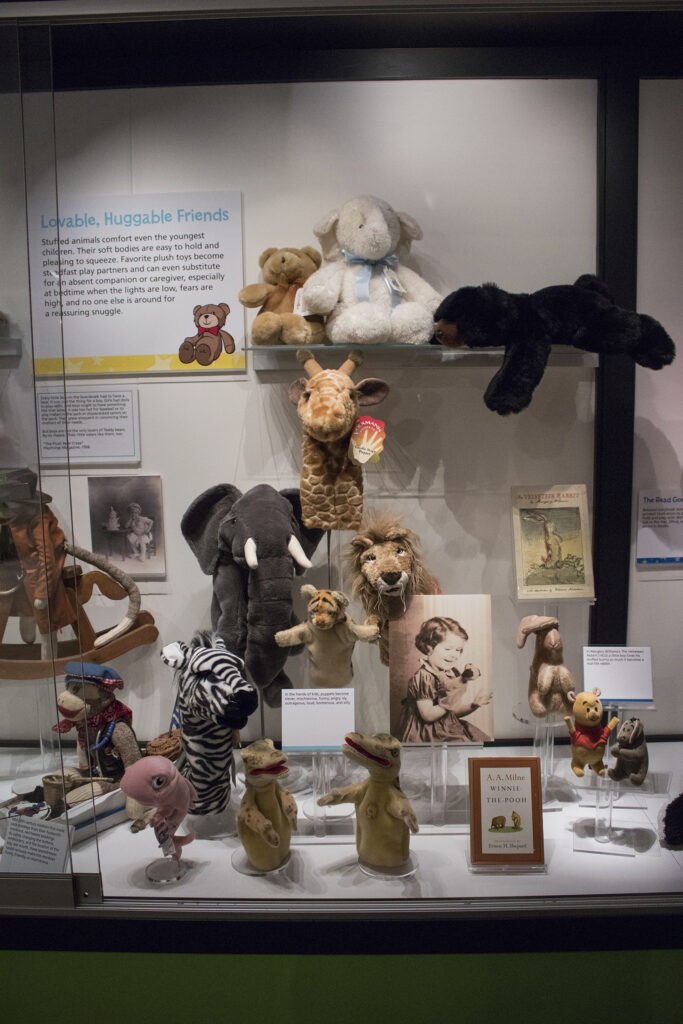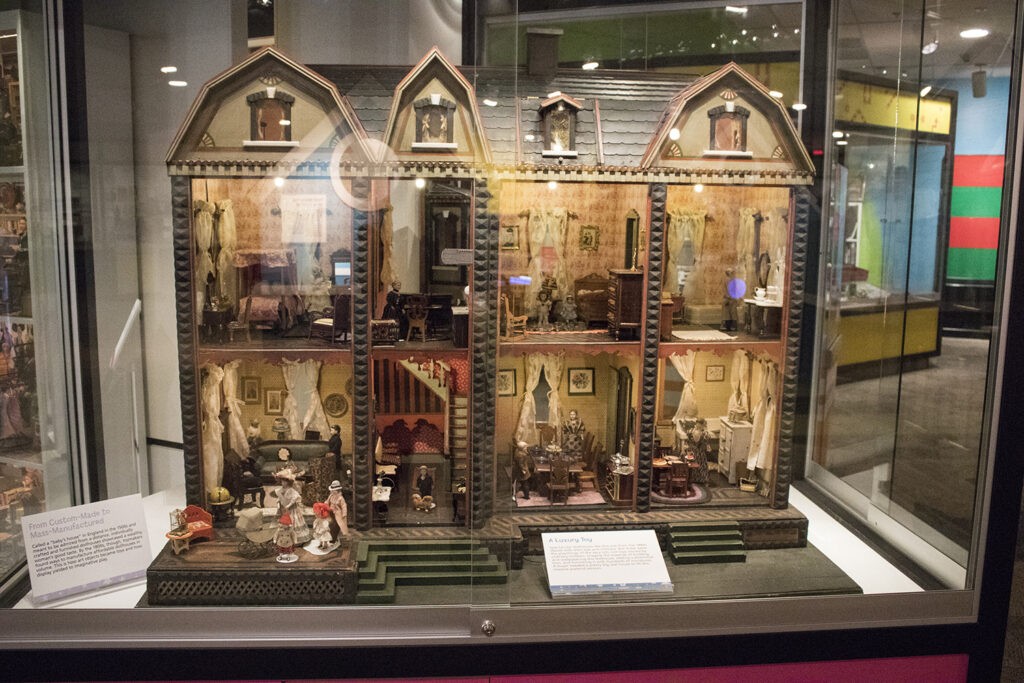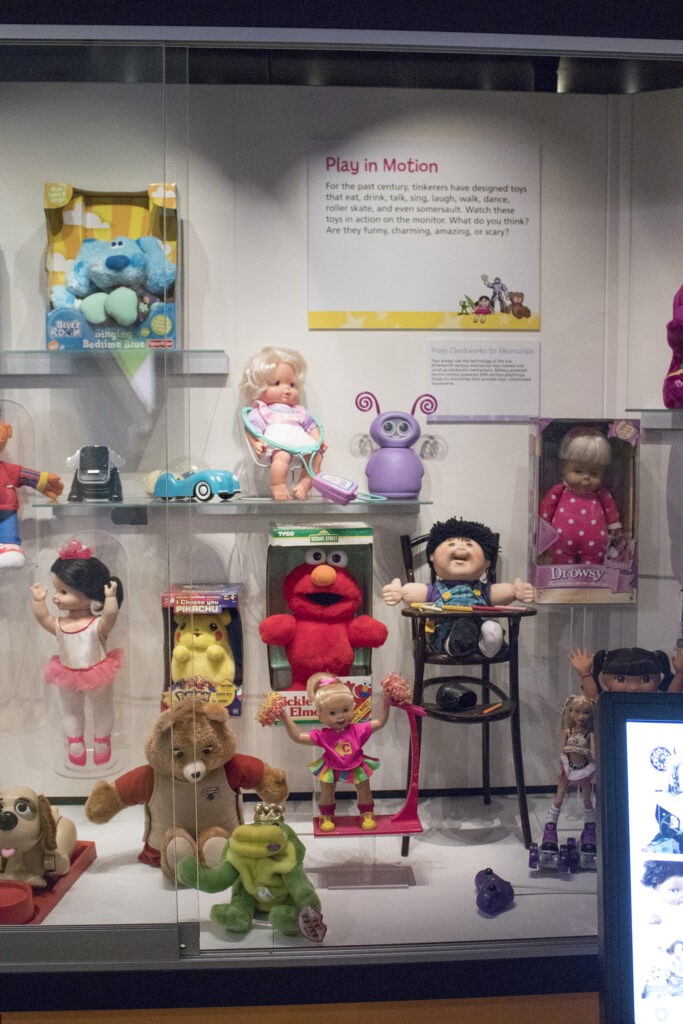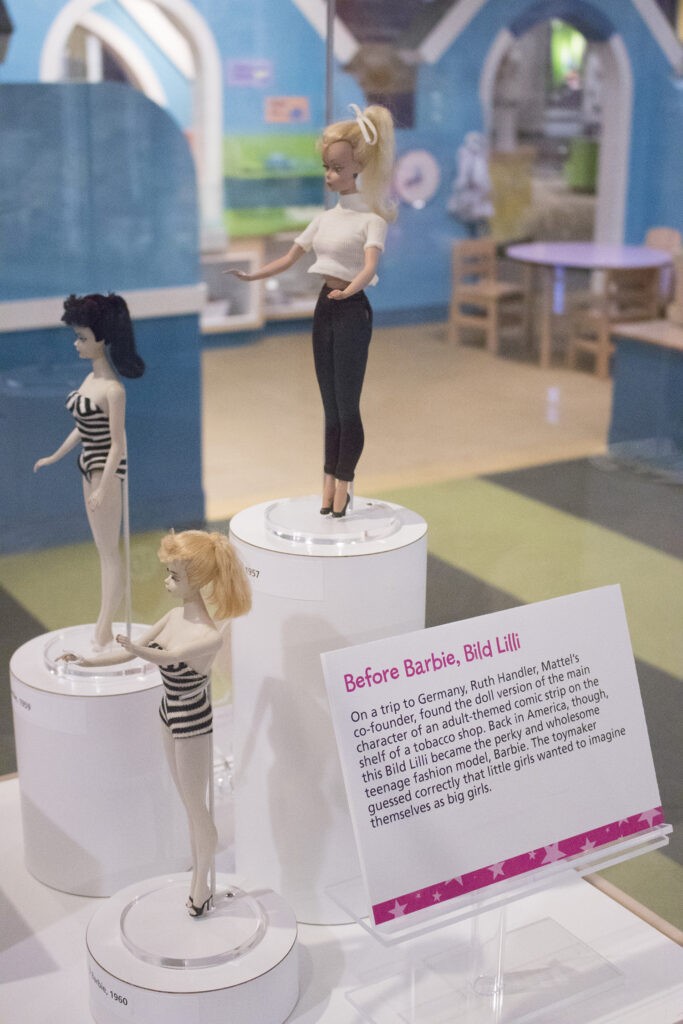For as long as play has existed, humans have been making dolls in some form or another. The ancient Egyptians carved figures of their deities, Roman children had dolls of famous gladiators, and as time progressed, these artificial chums became more intricate and advanced. Even Thomas Edison would throw his hat into the ring of manufacturing dolls, though he’d have little success with that venture. Nevertheless, the industry of dolls and action figures would be significant for much of human history. So come along with me as I take you on a narrative tour of The Strong’s Play Pals exhibit and discover what it reveals about these imaginative tools for play.
Making Sense of Make Believe
Dolls and action figures were, and still are, marketed to different demographics, usually divided along gender lines. This display case shows such a phenomenon with various toys which were marketed to boys and girls separately, with girls being advertised things like My Little Pony, Dora The Explorer, countless different baby dolls and more, while boys generally saw more things like G.I. Joe, superheroes, military-themed toys, and other more “manly” playthings. Sure, anyone could buy whatever they wanted, but let’s face it, toy companies had very specific ideas in the 20th century. Nowadays, the toy industry is much less divisive and more integrated. Boys can play with My Little Ponies and girls can play with Transformers. Think about your favorite toy as a kid. Did it fall into your gender demographic?
Disney Infinity 3.0
Figurines have become digital? Amazingly enough, yes! While Disney Infinity didn’t conceive this idea, it definitely went with it. This game combines two beloved pastimes: gaming and collecting. Place a figure on the “portal” and watch it take shape in your game. Choose from a wide variety of characters from different franchises, including the Disney Princesses, Pirates of the Caribbean, Marvel, Star Wars, and more. Do you have this game at home? How many figures do you have?

Lovable, Huggable Friends
Stuffed animals have been around for as long as anyone can remember. You probably owned a stuffed animal when you were young, and if you didn’t, you’ve definitely seen one. This display shows stuffed animals from as far back as 1902, with a felt menagerie of fun-loving creatures from teddy bears to Uglydolls. Did you have a favorite stuffed animal growing up?
GUND Teddy Bear Check-Up
Ever wanted to be a veterinarian? Here’s your chance. This miniaturized vet clinic lets you help a variety of animals. Scan your patient to find out what’s wrong and make a diagnosis. Perform a giant version of Operation to help heal a sick teddy. Measure your animal’s height to see how tall they are.
Toys Change but Play Remains the Same
This timeline of toys shows what kids played with since the 1860s, showing how much—and how little—has changed. Porcelain dolls dominated the industrial era and into the Roaring 20s, eventually turning into more sturdy materials like wood or iron. Come the 1950s, plastic became the best thing to make playthings with, and with the Cold War escalating, military and space toys began dominating the markets. With the Golden Age of Cinema came toys based on movies and TV shows, from Star Wars to Star Trek. The 1990s brought about a veritable toy renaissance with play icons like the Masters of the Universe, Cabbage Patch Kids, Tickle Me Elmo, and much more. The modern era of toys shows that dolls and action figures are here to stay and won’t be going anywhere anytime soon.
Material Girl
If you’ve ever seen a doll before, you’ve definitely seen Barbie. Created in 1959, this icon of play has outlasted countless toys in both popularity and manufacture. This display contains nearly 60 years of Barbie and her wardrobe, showcasing the most popular models of their respective year of release, from Friday Night Date, to Italian, to Incan Princess, to Dia de los Muertos. What was the most popular Barbie in the year you were born?

From Custom-Made to Mass-Manufactured
All that can be said about dolls can also be said of their homes. When they originally gained popularity in Europe during the 16th century, these so-called “baby houses” were originally intended to be looked at rather than played with. Over the centuries, children began to use them in tandem with dolls, essentially rebranding them as dollhouses. During the 1800s, they were seen as more of a luxury item, with extravagant dollhouses being custom built in traditional Victorian style. When dolls started to be mass produced, so too did their houses, giving rise to a massive tandem industry of toys. This display case shows a set of simple custom doll play sets featuring Barbie and Ken dolls, as well as an incredibly well-crafted vintage dollhouse from the 1890s. Did you have a store-bought dollhouse, or did you make your own with a cardboard box?
Make-Believe Play is Like a Vitamin
Have you ever wanted to step into a giant dollhouse? Now’s your chance. This jumbo dollhouse allows kids and their parents to play house, a common game among children. Do some pretend laundry, cook a lovely pretend dinner, and pick some pretend flowers in this life-sized playhouse lovingly constructed by the expert builders of The Strong museum.

Play in Motion
What’s better than playing with a toy? When the toy plays with you too! For more than a century, toy companies from Milton Bradley to Hasbro have been finding ways to bring toys to life. From Victorian-era clockwork toys to fully computerized talking animatronics, toys are more fun when they play with you while you play with them.
Mash-Up Make-Believe
Crossovers are very common when it comes to playtime, whether it’s the Masters of the Universe teaming up with the Thundercats to stop Lex Luthor or a cowboy fighting a G.I. Joe with a lightsaber. This display case has a lot of fun visuals from Chewbacca scaling a crane with a Power Ranger to a pioneer and a WWII soldier watching each other’s backs. For as long as toys have existed, kids have been making crossovers that would likely never happen. What toys did you like to mash up as a kid?
The Doll that Started a Museum
The Strong Museum gets its name from its founder, Margaret Woodbury Strong. Strong, like most children, was obsessed with play as a child, collecting dolls in her countless travels. Her very favorite of these dolls was Mabel, a small porcelain doll on display in the museum that bears her name. Mabel was made around 1900 and remains one of The Strong museum’s most treasured artifacts. What was your favorite toy as a child?
A Marvelous Monstrosity
Thomas Edison was known for many things, but toys were not among them. His first (and last) foray into toy invention was the Edison Talking Doll, an impressive invention in its own rite, though not something people were willing to buy. This doll relied on wax cylinders to speak and sing, resulting in a shrill, horrifying voice reciting nursery rhymes like a villain from a slasher movie. The doll failed to turn a profit, for obvious reasons, and Edison rapidly retired from the toy business. Which toy did you find scary as a kid? Was it Teddy Ruxpin? I know that one freaked me out.
G.I. Joe Prototype
Between the 1950s and 1990s, the American toy industry had a strange fascination with the military, likely due to the conflicts in Korea and Vietnam. One of the many toys to spawn from this fascination was the ionic and controversial G.I. Joe line of toys. But where do the origins of the “fighting man from head to toe” lie? The answer may surprise you: Barbie. The original concept of the manliest of toys came from Barbie’s boyfriend Ken. It almost seems too strange to be true, the idea of a doll marketed as the toy for girls being responsible for the premier toy for boys. Then again, companies will always evolve with the times, and G.I. Joe is tangible proof.

Before Barbie, Bild Lilli
G.I. Joe’s origins may be linked to Barbie, but where did Barbie herself come from? Believe it or not, the wholesome icon of girls around the world has some surprisingly mature roots. While on a trip to Germany, Mattel co-founder Ruth Handler came across a doll based on a raunchy comic strip called Bild Lilli. This doll, found in a tobacco shop, would be the catalyst for Mattel’s most iconic toy to date, one that has lasted more than 60 years. It may seem strange that an icon for little girls everywhere would stem from something so risqué, though as is usually the case with toys, truth is stranger than fiction.
By Declan Handley-Byrne, SELF Intern


